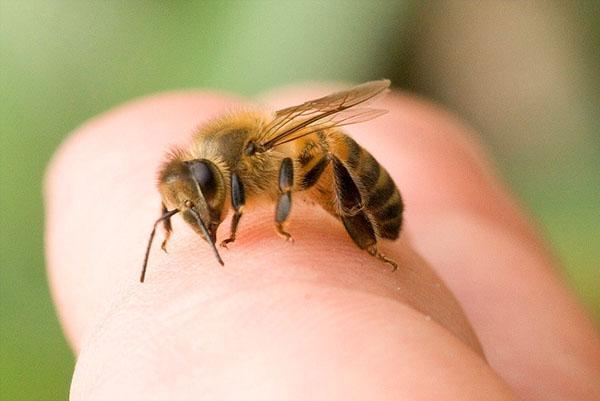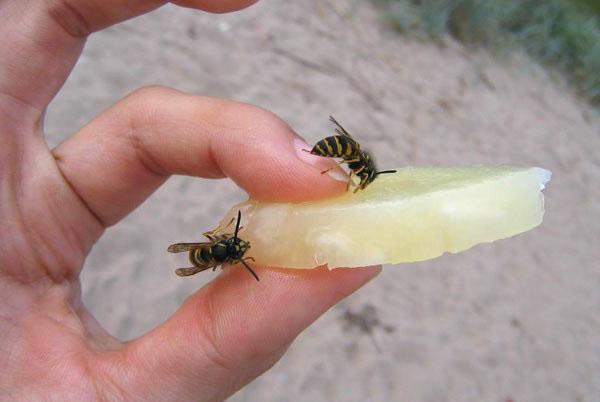The danger of a bee sting and first aid
 Unfortunately, work on a personal plot, and especially in an apiary in the summer, is sometimes overshadowed by not the most pleasant meetings. One potential danger is a bee sting. Beneficial insects are not aggressive, but under the confluence of circumstances they defend themselves by plunging a sting into the flesh of the offender.
Unfortunately, work on a personal plot, and especially in an apiary in the summer, is sometimes overshadowed by not the most pleasant meetings. One potential danger is a bee sting. Beneficial insects are not aggressive, but under the confluence of circumstances they defend themselves by plunging a sting into the flesh of the offender.
What if bitten by a bee? How to remove the sting, and do you need to seek medical help?
Symptoms and effects of a bee sting

Together with the sting, the toxic substance produced by the insect gets under the skin. Therefore, almost immediately after the bite, a burning sensation appears, soft tissues turn red and swell.
If you are prone to allergic reactions or hypersensitivity, nearby parts of the body turn red or become covered with a rash. General weakness, dizziness and even fever are not excluded. In some cases, people experience gagging, chills and seizures.
 Anaphylactic shock is a particularly serious consequence of a bee sting. This condition threatens:
Anaphylactic shock is a particularly serious consequence of a bee sting. This condition threatens:
- a sharp swelling of the mucous membrane of the oral cavity, larynx and respiratory organs;
- impaired respiratory function;
- the death of a person who could not receive timely help from doctors or ordinary people who happened to be around.
Such a manifestation of an allergy to a bee sting is not observed in all victims. However, it cannot be ruled out. The greatest harm to health is brought about by massive attacks of bees. If a person accidentally or intentionally disturbs the nest of wild insects or the inhabitants of the hive in the apiary.
First aid for a bee sting
What to do after a bee sting? In the very first moments, before the poison has time to spread and cause unpleasant symptoms, you should carefully remove the sting of the bee.
At home, this is easier to do with tweezers. When such a tool is not at hand, you can use any available means. You can use your own nails after disinfecting.
 The contents of the wound do not need to be squeezed out. A microscopic amount of poison has already penetrated into the tissues, and any mechanical effect on the site of the bee sting will only increase pain and may cause an external infection to enter.
The contents of the wound do not need to be squeezed out. A microscopic amount of poison has already penetrated into the tissues, and any mechanical effect on the site of the bee sting will only increase pain and may cause an external infection to enter.
In most cases, the pain subsides soon, but noticeable swelling appears at the site of the bite, accompanied by burning and itching. Even with a mild degree of damage, itching is dangerous because a person who scratches the skin unwittingly contributes to the development of a secondary infection and complications of the situation.
How to relieve swelling after a bee sting? At home, there are several ways to relieve a person's suffering. To do this, after disinfection of the lesion, use:
- cooling compresses with crushed ice, ammonia or plain water;
- lotions with baking soda gruel or food vinegar;
- topical medications;
- antihistamines.
Relief after a bee sting is given by menthol creams and ointments. These same remedies can help relieve annoying itching.In addition, cooling the skin prevents blood flow and the spread of toxins throughout the body.
As a result, the swelling from a bee sting, as in the photo, quickly subsides, which greatly facilitates the condition of the victim.
But the use of only local action is clearly not enough. To prevent dehydration, the victim is given copious unsweetened drinks. At the first sign of complications, it is necessary to take all measures to prevent and alleviate anaphylactic shock and other severe signs of allergy.
Emergency first aid for a bee sting
What to do at home if a bee has bitten, and the victim shows all the signs of a severe reaction to insect toxins?
 In this situation, one cannot hesitate. Immediately after calling the doctors, a person who has suffered from bee stings should be provided with peace and warmth. To remove the risk of edema, the patient is given an injection of antihistamines. In addition, it is important not to leave the person alone and at the same time to control:
In this situation, one cannot hesitate. Immediately after calling the doctors, a person who has suffered from bee stings should be provided with peace and warmth. To remove the risk of edema, the patient is given an injection of antihistamines. In addition, it is important not to leave the person alone and at the same time to control:
- heart rate;
- blood pressure indicators;
- the work of the respiratory system and the condition of the mucous membranes.
First aid after a bee sting may include emergency ventilation. Indirect cardiac massage and mouth-to-nose resuscitation may be needed.
What to do with a bee sting outside the city?
 How to remove a swelling from a bee sting if an accident happened in a suburban area, where the choice of medicines at hand is much less than in the city?
How to remove a swelling from a bee sting if an accident happened in a suburban area, where the choice of medicines at hand is much less than in the city?
First of all, don't worry about panicking. Not only is such a reaction unproductive, but it can also lead to impaired breathing and heart rhythm. This will only complicate the fight against the effects of a bee sting.
If the victim does not have obvious signs of allergy, then before receiving medical help, it is necessary to take measures to relieve pain and itching. At a summer cottage or on vacation, you do not always have the entire necessary arsenal of medicines at hand. Immediately after the bee sting, the sting is removed, the skin surface is washed and, if possible, disinfected.
Nature to help with a bee sting
And what to do next with a bee sting and complete absence of medication?
In the absence of allergies, to relieve swelling and skin irritation, itching and burning sensation, you can take "green medicines" that grow in the wild and in the garden.
Many plants have the ability to relieve suffering after a bee sting. You can pluck in any garden parsley leaves... Grind them and attach them in the form of a lotion to the place where the insect sting has recently been. Soon the swelling will decrease, and the itching will disappear imperceptibly. For greater effect, parsley foliage can be pre-doused with boiling water. This will enhance the secretion of juice and essential oil.
Plantain leaves and juice from this common plant have no less effect. In folk medicine, as first aid for a bee sting, it is recommended to use a compress made from chopped plantain greens and another wild crop, yarrow. The dressing with gruel is changed after two hours, when the grass mass loses its juiciness.
 A regular onion cut in half will disinfect the site of a bee sting and neutralize the toxins injected by the insect under the human skin. Despite the burning sensation that occurs when onion juice on damaged skin, the pain soon subsides, swelling and irritation subsides.
A regular onion cut in half will disinfect the site of a bee sting and neutralize the toxins injected by the insect under the human skin. Despite the burning sensation that occurs when onion juice on damaged skin, the pain soon subsides, swelling and irritation subsides.
 An excellent remedy not only relieving the symptoms of a sting, but also scaring off aggressive bees are garden plants such as mint and melissa. Leaves and flowers, rubbed in the fingers, release essential oils that have an active soothing and disinfecting effect.
An excellent remedy not only relieving the symptoms of a sting, but also scaring off aggressive bees are garden plants such as mint and melissa. Leaves and flowers, rubbed in the fingers, release essential oils that have an active soothing and disinfecting effect.
If you do not delay taking pre-medical measures, even with the help of the simplest improvised means, you can quickly and effectively alleviate the condition of the victim from bees.